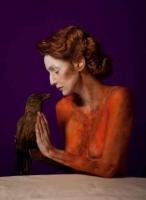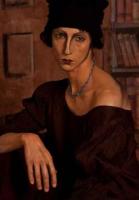
by Tom Fels
Establishing an independent artistic personality is a key challenge for most photographers, even more so when their name already conjures up one of the best known figures in the field. For photographers in the second half of the twentieth century, the work of Diane Arbus brought a sea change, the arrival of a significant personal vision which has been characterized as rendering strange the familiar and uncovering the familiar in the strange. Most conversant with the art of the past few decades would recognize her work.
For her daughter Amy the first solution was to stay away. She didn’t take up photography seriously until her early twenties. From that point on, however, she has been determined to blaze a path of her own. Today, decades later, we can see where her efforts have taken her.
Beginning as a photographer of life on the streets of New York, Amy Arbus developed a
reputation as a keen observer of personality and style. Her ability earned her a ten-year stint showcasing her vision in the pages of The Village Voice, a perch from which she developed two  of her five books. A master class with Richard Avedon boosted her confidence. To support her foray into the arts she forged a commercial practice whose cast of periodical editors and advertising clients places her in the company of industry leaders. She teaches photography at The International Center of Photography, exhibits widely, and her work is represented in the collections of The National Theater in Norway, The New York Public Library and The Museum of Modern Art in New York.
of her five books. A master class with Richard Avedon boosted her confidence. To support her foray into the arts she forged a commercial practice whose cast of periodical editors and advertising clients places her in the company of industry leaders. She teaches photography at The International Center of Photography, exhibits widely, and her work is represented in the collections of The National Theater in Norway, The New York Public Library and The Museum of Modern Art in New York.
Although the subjects of Arbus’ several bodies of work and their resulting books have differed, consistent themes run through them. One is her devotion to the portrait, even in adapted and expanded form. Another is her instinct for the expressiveness of demeanor and dress. Commenting on her work for the Voice, later published as On the Street:1980-1990 (2006), Vince Aletti wrote, “Arbus clearly understands the power of clothes to express personality; the best of her work is a seamless blend of fashion and portraiture.” His view was born out by the 1983 street portrait that graced the cover of On the Street: the then little known, but already prepossessing Madonna.
 The pieces in After Images also stem from a fourth theme in Arbus’ work: the theater. Long aware of the dramatic impact of a well framed image – all four of Arbus’ immediate family have been involved in photography or film – Arbus, in the work that became The Fourth Wall (2008), made use of actors and their milieu to launch scenes that reflected obliquely back on them, taking actors who were still in character out of the context of the theater to show how fictional characters seem every bit as real as life itself. For the actors and models of After Images: costume, makeup, and paint are now used freely, poses are studied, and backgrounds and lighting are the work of a production team. Clearly, though, as in her other work, Arbus directs. (Only in her project to photograph newborns, she has said, did she entirely capitulate to the whims of nature.) The result is a more refined and focused product, augmented by fine printing and presentation, and cemented by the compositions of the classic paintings to which she pays homage.
The pieces in After Images also stem from a fourth theme in Arbus’ work: the theater. Long aware of the dramatic impact of a well framed image – all four of Arbus’ immediate family have been involved in photography or film – Arbus, in the work that became The Fourth Wall (2008), made use of actors and their milieu to launch scenes that reflected obliquely back on them, taking actors who were still in character out of the context of the theater to show how fictional characters seem every bit as real as life itself. For the actors and models of After Images: costume, makeup, and paint are now used freely, poses are studied, and backgrounds and lighting are the work of a production team. Clearly, though, as in her other work, Arbus directs. (Only in her project to photograph newborns, she has said, did she entirely capitulate to the whims of nature.) The result is a more refined and focused product, augmented by fine printing and presentation, and cemented by the compositions of the classic paintings to which she pays homage.
After Images is a departure from her earlier work, with its array of personal artistic favorites like Picasso, Cezanne, and Modigliani. Her subjects are drawn from the outré world of a century
before (with a nod to the earlier David and Regnault), is a novel extension into new territory, a
bold step along the well developed path she has worked to create.
AFTER IMAGES / AMY ARBUS
April 30 – May 24, 2015
Mitchell • Gidings FIne Arts, 182 Main Street, Brattleboro VT 05354
www.mitchellgiddingsfinearts.com, info@mitchellgiddingsfinearts.com
(802) 251-8290
Link to more about this exhibit: http://mitchellgiddingsfinearts.com/index.php/exhibits/amy-arbus-after-images.html#!Amy_Arbus__Anna__Sarabeth___Syrie___After_Graces__2012__72_dpi








More Time with Amy Arbus on May 2
Saturday, May 2 from 5 – 7pm come back to MGFA for an artist talk and book signing!
Here is a link to the facebook event page: https://www.facebook.com/events/563357837140472/
upside down
This art is almost the opposite of photo-real painting. Rather than try to paint something that looks like a photo, this turns it on its head.
Great idea and style.